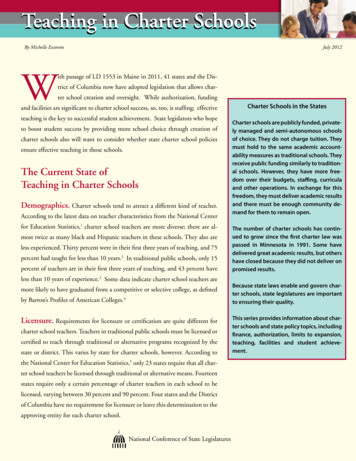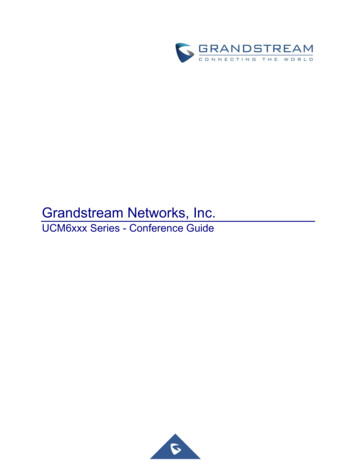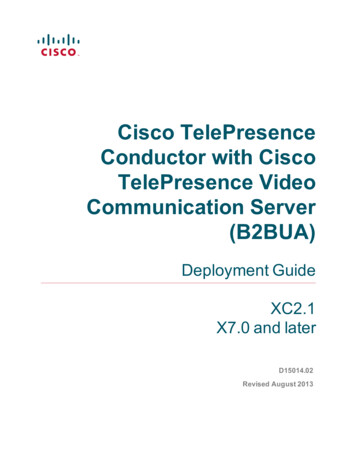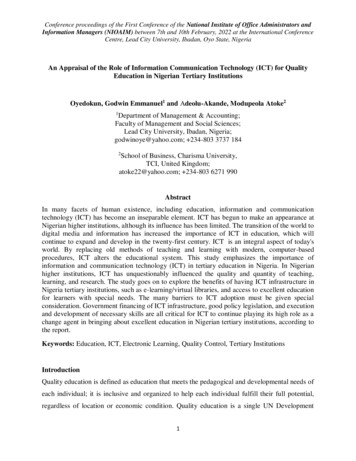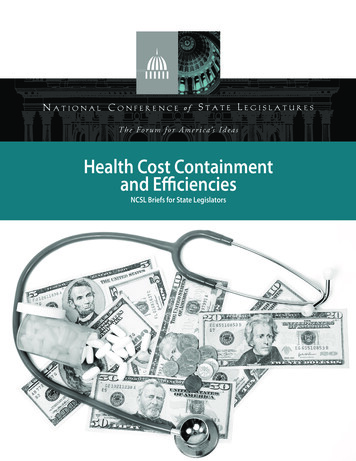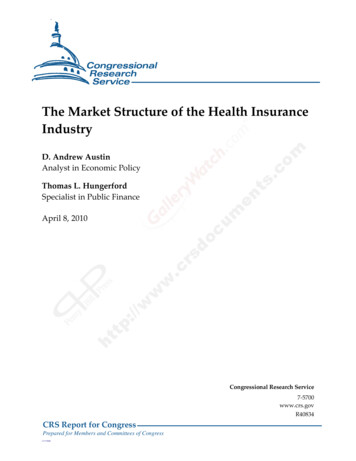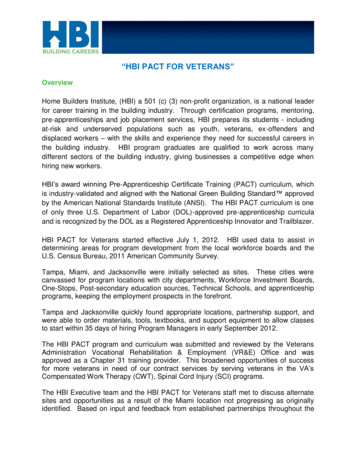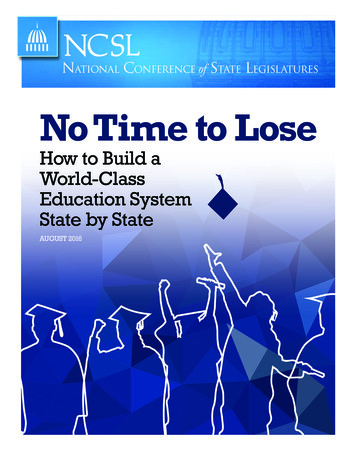
Transcription
NATIONAL CONFERENCE of STATE LEGISLATURESNo Time to LoseHow to Build aWorld-ClassEducation SystemState by StateAUGUST 2016
NCSL’s Study Group on InternationalComparisons in EducationThe National Conference of State Legislatures hosted a plenary session during its2013 Fall Forum to discuss the results of the Organisation for Economic Co-operationand Development’s (OECD) most recent survey of what 15-year-olds in industrializedcountries could demonstrate about their knowledge of reading, mathematics and science. This survey is known as the Programme for International Student Assessment(PISA). Upon hearing of the disappointing performance of students in the U.S., officersof NCSL’s Standing Committee on Education requested that NCSL launch a legislative study into international comparisons of high-performing education systems. Theywanted to study other high-performing countries to learn which policies and practiceswere in place and what lessons the U.S. and individual states might learn from theirsuccess. They also wanted to learn about the consequences for our economy andquality of life if we failed to improve our standing.A bipartisan group of 28 veteran legislators and legislative staff, along with severalpartners from the private sector, began an 18-month study in 2014. They focused onthe highest performing countries on PISA to discover commonalities across their policies and practices. They met with education leaders from these countries, along withnational and international experts who study their systems. They also visited severalcountries to see the differences firsthand.This first report explains why there’s no time to lose in rebuilding state educationsystems. However NCSL’s study group still has questions—and surely the reader doestoo—about how to design and implement these systemic changes in the states. Whereshould legislators begin—teacher recruitment or preparation, standards, assessments,early learning? How should states realign their resources? Do some of these policies fittogether better into an actionable package? There is still much to learn and discover.The study group members will continue to meet through 2017 to find the answersto these and other questions by continuing to study and learn from other successfulcountries, as well as districts and states here in the U.S. Upon completion of our study,the study group will produce a policy roadmap that states can use to guide their reforms, as well as provide support to states ready to embark on these efforts.NATIONAL CONFERENCE OF STATE LEGISLATURES2
EXECUTIVE SUMMARYWe are discovering whatseems to work. Commonelements are present innearly every world-classeducation system, includinga strong early educationsystem, a reimaginedand professionalizedteacher workforce, robustcareer and technicaleducation programs, anda comprehensive, alignedsystem of education.The bad news is most state education systemsare falling dangerously behind the world in anumber of international comparisons and onour own National Assessment of EducationalProgress, leaving the United States overwhelmingly underprepared to succeed in the21st century economy. The U.S. workforce,widely acknowledged to be the best educatedin the world half a century ago, is now amongthe least well-educated in the world, accordingto recent studies. At this pace, we will struggleto compete economically against even developing nations, and our children will struggle tofind jobs in the global economy.States have found little success. Recent reforms have underperformed because of silverbullet strategies and piecemeal approaches.Meanwhile, high-performing countries implement policies and practices and build comprehensive systems that look drastically differentfrom ours, leading them to the success thathas eluded states. Pockets of improvement ina few districts or states is not enough to retainour country’s global competitiveness.The good news is, by studying these otherhigh-performing systems, we are discoveringwhat seems to work. Common elements arepresent in nearly every world-class educationsystem, including a strong early educationsystem, a reimagined and professionalizedteacher workforce, robust career and technicaleducation programs, and a comprehensive,aligned system of education. These elementsare not found in the U.S. in a consistent, welldesigned manner as they are found in highperformers.Build an Inclusive Team and Set Priorities. Study and Learn from Top Performers. Create a Shared Statewide Vision.Benchmark Policies. Get Started on One Piece. Work Through “Messiness.” Invest the Time.We must directly face these challenges and begin immediately to reimagine and re-engineerour own education system. We must implement meaningful and comprehensive changesthat will produce real results for our students.We have the ability to turn things around.Much higher-performing, yet less-developedcountries—such as Poland and Singapore—have made significant progress developingtheir education systems in just a decade ortwo because they felt a strong sense of urgency. State policymakers, too, can get started right away to turn around our educationsystem by taking immediate steps to: State legislators must lead this work. Education is first and foremost a state responsibility.Each state can develop its own strategies forbuilding a modern education system that isglobally competitive, similar to the approachtaken by other high-performing countries.But we must begin now. There’s no time tolose.3NATIONAL CONFERENCE OF STATE LEGISLATURES
NCSL STUDY GROUP REPORTWe cannot ignore the reality that most stateeducation systems are falling dangerouslybehind the world, leaving the United Statesoverwhelmingly underprepared to succeedin the 21st century economy.The U.S. workforce, widely acknowledgedto be the best educated in the world half acentury ago, is now among the least welleducated, according to recent studies. At thispace, we will struggle to compete economically even against developing nations, and ourchildren will struggle to find jobs in the globaleconomy.But we must begin now. There’s no time tolose. We must directly face these challengesand begin immediately to reimagine and reengineer our own education system. We mustimplement meaningful and comprehensivechanges that will produce real results for ourstudents.Each state can develop its own strategies forbuilding a modern education system that isglobally competitive, similar to the approachtaken by other high-performing countries.These countries did not copy each other; instead they borrowed and adapted ideas, manyfrom the U.S., and customized their approachfor their own unique context.Despite their efforts, states have found littlesuccess because recent reforms have underperformed. Meanwhile, high-performingcountries implement policies and practicesand build comprehensive systems that lookdrastically different from ours, leading themto the success that has eluded states. Pockets of improvement in a few districts or statesare not enough to retain our country’s globalcompetitiveness.State legislators must be at the center of thisdiscussion. Education is first and foremost astate responsibility. State legislators representand can bring together the diverse viewpointsat the state and local levels that must be included in setting a vision and priorities for reforms. States must work together with localentities to design efforts that are practical andappropriate for each individual state. We willnot be successful by allowing the federal government to set agendas and priorities.The good news is that we have the ability toturn things around. Much higher-performing,yet less-developed countries—such as Polandand Singapore—have made significant progress developing their education systems injust a decade or two, and most of their innovations came from right here in the U.S.NATIONAL CONFERENCE OF STATE LEGISLATURES4
BuildingConsensusThe recent reauthorization of the Elementaryand Secondary Education Act as the EveryStudent Succeeds Act (ESSA) moves federaleducation policy away from the top-down, punitive approach that has been in place since2002. States now have more flexibility to reimagine their accountability systems, designinterventions to improve instruction, and usefederal resources to support students andschools in more flexible ways. At the sametime, states will continue to have the dataneeded to monitor the performance of student subgroups, ensuring a focus on a highquality education for all children.It is unrealistic to expect that every person,group or interest will be 100 percentin favor of every idea or strategy. So, itmight be wise to establish a threshold forESSA provides an opportunity for states toensure that all students have the knowledge,skills, abilities and behaviors to succeed in college and the workplace so that jobs stay inour states rather than going overseas. Thesechanges represent both an opportunity and achallenge for states, and lessons from highperforming countries offer timely guidelinesfor states at this opportune time.support to move forward. For example,the group might adopt a “70 percent rule”:An idea or decision is approved if 70percent of the group is in favor.would give up. In addition, it is unrealistic toexpect that every person, group or interestwill be 100 percent in favor of every idea orstrategy. So, it might be wise to establish athreshold for support to move forward. Forexample, the group might adopt a “70 percent rule”: An idea or decision is approved if70 percent of the group is in favor.HERE ARE STEPS THAT STATES CANTAKE IMMEDIATELY.Build an Inclusive Team and Set Priorities. State legislators cannot do this workalone. They must assemble a broad anddiverse group that brings state and localpolicymakers, teachers, principals, superintendents, unions, business, parents and students into an inclusive process to set a visionfor reform and identify priorities. State legislators know that it is very difficult to achieveagreement on reimagining and building a21st century education system. But everyperson or group cannot get everything theywant, so we recommend a different approachto achieving a collective and realistic vision:To build consensus, every stakeholder in thediscussion is expected to put on the table aproposition giving them something they never thought they could get, in exchange forgiving up something they never thought theyStudy and Learn From Top Performers.Every state should embark on a journey similar to that of the NCSL study group—a journey to discover the policies and practices ofother high-performing countries. Reconsidermuch of what you think you know; abandonmany ideas to which you have long been committed; and embrace new ideas, many whichcome from other countries but also thosealready implemented in many of our states.Study innovations in the states. Look hard atstatewide data and be unafraid to compareyour own state to other states and countries.To build consensus, every stakeholder in the discussion is expectedto put on the table a proposition giving them something they neverthought they could get, in exchange for giving up something theynever thought they would give up.5NATIONAL CONFERENCE OF STATE LEGISLATURES
ing system-wide reform is always difficult andmessy. There is no one recipe for success. Thetop performers took at least one step backwardfor every two steps forward, but continued tokeep their eye on the goal to stay the course.n FROM THE STUDY GROUP“Many states have implementedindividual education reformsbut have not accomplished theresults hoped for. One of theInvest the Time. States embarking on thisprocess will find that they cannot tackle everything at once and will need to prioritize theirwork. We urge states to define these priorities as part of an inclusive process that firstidentifies a statewide vision and ensures thatindividual strategies are all needed parts forachieving statewide goals. States will beginthis process at different places and will designdifferent pathways. Achieving system-widechange will take time and will begin and endin different places in different states.most important lessons I have learned duringthis study is the value of having a well thoughtout and widely accepted vision that includes thecoordination of multiple reforms to produce aworld-class education system.” — State Senator John Ford, R-Okla.Create a Shared Statewide Vision. Developing a shared long-term vision and settinggoals to guide the work will be critical to thesuccess of the effort. The vision becomes aguide for policymaking that transcends theshifts in politics or personalities. The vision becomes the North Star that continually guidesthe work. The journey will not be a short one,but a good roadmap—knowing where to goand developing the way there—means thatpolicymakers will ultimately arrive at the desired destination.State policymakers can take these first actionsteps to quickly begin to move their statesfrom mediocrity to excellence.But first policymakers must face and understand the facts—the unfortunate state of ourcurrent education system. Then policymakersmust understand the common elements foundin world-class education systems.Benchmark Policies. After establishinga shared vision, the state should considerbenchmarking its education policies, practicesand outcomes against those of high-performing countries and high-performing states. Thishelps to identify specific policies and implementation strategies for necessary shifts inpolicy and practice. An ongoing benchmarking process also allows the state to continuallymonitor its results.Facing Facts: U.S. Studentsand Workers StrugglePOOR SCORES ON PISAIn 2000, the Organisation for Economic Cooperation and Development (OECD) embarked on its first international comparativestudy of what a sample of 15-year-olds candemonstrate about their knowledge in keyareas including math, reading and science. 1This assessment is known as the ProgrammeGet Started on One Piece. After creating acomprehensive strategic plan, states shouldget started right away on a priority area ofreform. Building a cohesive system does notmean states should wait to implement allpieces together, but rather understand andemphasize the connectedness of policy pieces. We urge states to move forward now todesign and implement priority reform strategies, such as early literacy, teacher preparation, or college and career pathways. Identifyan important early success that supports thestate vision and the strategic plan, and usethe success as momentum for continuous improvement.After all of the national, state anddistrict reform efforts during thedecade following No Child Left Behind,the U.S. was outperformed not only bya majority of the advanced industrialnations, but by a growing number ofWork Through “Messiness.” In both highperforming countries and in successful reformefforts here in the U.S., the process of design-NATIONAL CONFERENCE OF STATE LEGISLATURESless-developed nations as well.6
U.S. RANKING ON PISAabout in the middle of the countries surveyed. The initial results emboldened someU.S. policymakers to call for reforms, suchas more testing and accountability and minimum qualifications for teachers. At the sametime, the federal No Child Left Behind (NCLB)Act was enacted.The Programme for International Student Assessment (PISA) isa comparative study of 15-year-old students’ knowledge in keyareas including math, reading and science.YEAR(COUNTRIESTESTED)U.S. RANKINGREADINGMATHSCIENCE2000 (32)15th19th14th2003 (41)18th 28th 22nd2006 (57)2009 (65)2012 (65)NRWhen the fifth survey was administered in2012, the number of countries in the surveyhad grown to 65, and included less-developed countries. The news was worse for theU.S., which placed 24th in reading, 36th inmathematics and 28th in science. Again, ourstanding was in the middle of the countriessurveyed. After all of the national, state anddistrict reform efforts during the decade following NCLB, the U.S. was outperformed notonly by a majority of the advanced industrialnations, but by a growing number of less-developed nations as well. 234th 28th17th 30th 22ndPOOR SCORES ON PIAAC24th 36th 28thThe OECD also administers another surveycalled the Survey of Adult Skills, which is partof its Programme for the International Assessment of Adult Competencies (PIAAC). It surveys adults ages 16 to 65 in numeracy, literacyand problem-solving. The results from themost recent survey, conducted in 33 nations,were released in 2013.SOURCE: NATIONAL CENTER ON EDUCATION AND THE ECONOMY,CENTER ON INTERNATIONAL EDUCATION BENCHMARKING, 2013n FROM THE STUDY GROUP“It’s easy to say that the U.S. isn’tThe Educational Testing Service (ETS) did aspecial analysis of the 2013 PIAAC data onmillennials—those in the workforce rangingin age from teens to early 30s. They arguedthat this generation “will largely determine theshape of the American economic and sociallandscape of the future.” ETS found that onlythe millennials in Spain and Italy scored loweron the PIAAC survey in reading than millennials in the U.S. In numeracy, U.S. millennialstied for last with Italy and Spain. In problemsolving, U.S. millennials again came in lastamong the 33 nations.Singapore or Finland so there’snot much to learn from them.Well, 30 years ago, even Finlandwasn’t Finland. And some of the things theydid such as improving teacher preparation isclearly something we can do irrespective ofculture, homogeneity, diversity and so on.” — State Representative Roy Takumi, D-Hawaiifor International Student Assessment (PISA).Research has proven that a strong educationsystem contributes directly to a strong economy. Understanding how strong education systems in industrialized countries are designedcan help us uncover how they contribute toeconomic success and improve their citizens’quality of life.POOR PERFORMANCE ON OUR“NATION’S REPORT CARD”Not only are U.S. students struggling to compete globally, they also struggle to meet therelatively low expectations set for studentsthrough our own “Nation’s Report Card,” orthe National Assessment of Educational Progress (NAEP). For the four decades this assessment has been administered to studentsIn the first study, 32 highly-industrializedmember countries participated. The U.S.ranked a disappointing 15th in reading, 19thin mathematics and 14th in science—right7NATIONAL CONFERENCE OF STATE LEGISLATURES
LONG-TERM NATIONAL ASSESSMENT OFEDUCATIONAL PROGRESS (NAEP) SCORESOver the past four decades, high school students in the U.S. have made little progressaccording to the “Nation’s Report Card,” administered by the NAEP.READING320S C A L ES C O R 4Y E A R9699Ages:MATHEMATICS040812 17 13 9320306304S C A L ES C O R 9040812Y E A RSource: National Center for Education Statistics (2012). Trends in Academic Progressacross the country, high school students havemade little improvement.tems and drive economic development. Theyrealized that they needed to turn their education systems around to compete in a globaleconomy. Some in the U.S., however, explained away the results by criticizing the PISAand PIAAC methodology, denied that education results in other countries could be compared to those in this country, or argued thatINTERNATIONAL COMPARISONSARE VALIDWhen these survey results were first releasedin the 2000s, many countries enacted sweeping changes to improve their education sys-NATIONAL CONFERENCE OF STATE LEGISLATURES8
UPPER SECONDARY GRADUATION RATES, 2013The OECD reports that the U.S. graduation rate is 80 percent, lower than most other high-performing countries. This dispels theassertion that other high-performing countries educate only their elite.Over 25 years old2013Below 25 years old10090P E R C E N T8070605040302010NewZealanPo drtugaIre llandFinSw landitzerlaDe ndnmarkIsraeAu lstriaPolandChileCanadaSlo Slovvaek R niaepublicOECD LatAv viaeragHu engaryNUn orwaitedS ytateSw sedenCzItaechRlyepubCo liclomLubixemb aourgSpainTurkeIndo ynesiaMexico0Source: OECD (2015), Education at a Glance 2015: OECD Indicators, OECD Publishing. http://dx.doi.org/10.1787/eag-2015-en, p. 48PERCENT OF STUDENTS WHO ARE IMMIGRANTSEurope and Asia have experienced an upsurge in immigration over the past several decades, andAsian countries have significant cultural, linguistic, ethnic and religious diversity.5034.73029.5202118.3OECD average: dStnaUnCaHongKong-CSource: OECD. Table A2.1. and EAG database. SeeAnnex 3 for notes oniaresdahina0JaUpper secondary graduation rates (2013)Taiwan3.3aP E R C E N T40Source: OECD PISA 2012NATIONAL CONFERENCE OF STATE LEGISLATURES
ELEMENTS OF A WORLD-CLASSEDUCATION SYSTEMinternational comparisons are irrelevant. Thiscriticism continues even today as the UnitedStates falls further and further behind.Children come to school ready to learn, and extrasupport is given to struggling students so that allhave the opportunity to achieve high standards.The NCSL study group’s conclusions werevery different. They found that U.S. students’poor performance cannot easily be explainedaway. For example, critics assert that the U.S.educates all students while the other highperforming countries educate only their elite.But graduation rates dispel this assertion. TheOECD reports that the U.S. graduation rate is80 percent, lower than most other high-performing countries.n Necessary resources ensure that all children enter the first grade with thecognitive and non-cognitive skills needed to master a first-grade curriculumset to high standards.n Once students are in school, resources are distributed so that studentswho may find it harder to meet high standards will be given the extraresources—especially highly effective teachers—they need to succeed.A world-class teaching profession supports aworld-class instructional system, where everystudent has access to highly effective teachers andis expected to succeed.n The highly professional teaching force is well-prepared, wellcompensated and well-supported throughout their careers.n Teachers support a well-designed instruction system that includeshigh standards for learning, a core curriculum created by world-classteachers, and high-quality assessments designed to measure complex skillsdemanded by the standards and curriculum.n All students are expected to be ready for college and career, and alleducators are expected to get them there.A highly effective, intellectually rigorous systemof career and technical education is available tothose preferring an applied education.n A powerful, hands-on applied curriculum is built, requiring strongacademic skills.n The system has no “dead ends,” and pathways to university are clear andalways available.n Schools partner with employers to ensure that high standards are set forthe students and provide on-the-job training and learning opportunities toenable them to reach those standards.Individual reforms are connected and aligned asparts of a clearly planned and carefully designedcomprehensive system.n All policies and practices are developed to support the larger educationsystem.n The coherent system of education is designed to ensure that everystudent meets the same goal of college and career readiness.NATIONAL CONFERENCE OF STATE LEGISLATURES10Critics also assert that the U.S. is more diversethan other countries and, as a result, faceschallenges that others do not. This may havebeen true in the past, but it is not the case today. Both Europe and Asia have experiencedan upsurge in immigration over the past several decades. The same is true of Canada. Agreater proportion of Canadian students wasborn outside Canada than the proportion ofU.S. students born outside the U.S. Furthermore, Asian countries have significantly morecultural, linguistic, ethnic and religious diversity than many Americans often suppose. Forexample, Singapore has three main ethnicgroups (Chinese, Malay and Indian), four national languages (Mandarin, Malay, Tamil andEnglish) and a host of major religions, including Buddhism, Islam, Christianity, Hinduism,Sikhism, Taoism and Confucianism.Facing Facts:U.S. PolicymakersStruggle to FindSilver BulletOver the past several decades, policymakersin the U.S. have worried about flat test scoresand fledgling international competitiveness.In an effort to boost achievement for all students, policymakers have tried a number ofapproaches and passed a number of state andfederal laws. These have included increasing funding, reducing class size, enhancingschool choice, improving school technologyand teacher quality, more testing and toughertest-based accountability. While some policieshave had marginal success in some states ordistricts, success has not been as widespreadas policymakers had hoped.
funds from unproven strategiesn FROM THE STUDY GROUP“Every championship team, nomatter what sport, knows thefundamentals of the game andpractices those relentlessly. Ibelieve we have identified the fundamentalsof education that are necessary to succeed inpreparing our children to be internationallyis imperative that we acknowledge and adoptthose fundamentals if we are to be championsin education again.” — State Senator Luther Olsen, R-Wisc.The only policy approach developed by bothU.S. states and top-performing countries ishigh academic standards. But all of the topperforming countries have coupled developingsuch standards with a curriculum framework,specific curriculum and well-aligned, highquality, essay-based assessments in seamlessinstructional systems. Most states have yet tomove in this direction, and implementationof rigorous standards has been haphazard atbest. Improving early education without continuing supports for struggling studentsin K-12 Increasing funding without first shifting Using test scores in teacher evaluationswithout ensuring that all teachers are receiving job-embedded, high-quality, ongoing learningTOP PERFORMERS: HOW THEY BECAMETHE BEST IN THE WORLDAs NCSL’s study group talked with experts fromaround the world and visited several top-performing countries, they confirmed what othershad found—there are common elements thatmake up the design of world-class educationsystems. These elements are widely creditedfor their rapid rise in student achievement.Element #1: Children come to schoolready to learn, and extra support isgiven to struggling students so that allhave the opportunity to achieve highstandards.In retrospect, the NCSL study group concludes that states have tried to find individual“silver bullets” without setting decisive goalsand creating a thoughtful, systemic approachto building a coherent system with an appropriate timeline for implementation, as did theother high-performing countries. Examples ofstates’ piecemeal approaches include:Increasing teacher pay without demanding better preparationDecreasing class size without first restructuring staffing and timeThis “silver bullet” approach is not what thestudy group found in high-performing countries. They do not look to single policy shiftsto improve student outcomes. Instead, theyhave created a coherent system of educationwithin which all policies and practices are designed to lead to high performance.competitive in today’s changing economy. It The top-performing countries ensure thatchildren arrive at school ready to learn. Theresponsibility for this varies among the countries. For example, in high-performing countries with a large proportion of women in theworkforce, the government typically providessupport to families with young children. Inother countries, however, the responsibilityfalls on families—often extended families—and the community.Once students in top-performing countries are in school, those whostruggle receive extra help . More teachers are typically allocated tosuch schools, with the best teachers serving in the most challengedones. Inversely, American students from the wealthiest communities aremost likely to get the best teachers and the finest facilities.11NATIONAL CONFERENCE OF STATE LEGISLATURES
31257THE TENREGIONS STUDIED12345678910Alberta, CanadaEstoniaFinlandHong Kong, ChinaOntario, CanadaJapanPolandShanghai, ChinaSingaporeTaiwanIn both situations, society places a high priority on making sure that children are in goodhealth and prepared to learn. In most cases,if the families cannot or will not provide thesesupports to children, then society steps in.These supports often continue after childrenbegin school.that may overwhelm the school’s capacityto provide an adequate education. Becausehigh-performing countries provide supportsto ensure that children are ready for school,their schools typically do not face similarchallenges.5Once students in top-performing countries arein school, those who struggle receive extrahelp to reach the same high standards other students will reach more easily. Providingadditional resources to schools serving dis-In the United States, children in poverty nowaccount for about a quarter of all children inpublic schools. Large numbers of Americanchildren enter first grade with disadvantagesNATIONAL CONFERENCE OF STATE LEGISLATURES12
Once teachers exit a preparationprogram in top-performing countries,they are expected to be the best inthe world and experts in their craft.American programs typically havelower standards for entrance and exit,overproduce elementary educationteachers, and struggle to produce6teachers in high-demand fields, such84as special education and science,10technology, engineering and math.Element #2: A world-class teaching profession supports a world-classinstructional system, where everystudent has access to highly effectiveteachers and is expected to succeed.9When the top performers committed to bringing all students to achievement levels formerly reached only by their elites, they alsocommitted
are falling dangerously behind the world in a number of international comparisons and on our own National Assessment of Educational Progress, leaving the United States over-whelmingly underprepared to succeed in the 21st century economy. The U.S. workforce, widely acknowledged to be the best educated in the world half a century ago, is now among
